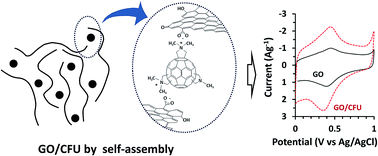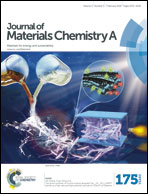Graphene oxide self-assembled with a cationic fullerene for high performance pseudo-capacitors†
Abstract
Control of the microstructures of graphene oxide (GO) is realized by introducing a cationic fullerene (CFU), resulting in a high-performance pseudo-capacitor. The strong electrostatic interaction between anionic GO and the CFU produces a self-assembled composite (GO/CFU), in which the CFU units intervene to form randomly stacked GO layers. The CFU acts as a spacer between GO layers, allowing a significant fraction of the oxygen-functional groups of GO to be redox-active. When tested as a pseudo-capacitor in 1.0 M H2SO4, the optimized GO/CFU composite delivers a capacitance of 357 F g−1 at 0.4 A g−1, in contrast to 160 F g−1 for GO alone, which is one of the greatest values reported for graphene composites with electro-inactive carbonaceous entities. The improvement in the capacitance by CFU incorporation is also evidenced at a high charge/discharge rate (285 and 137 F g−1 at 5 A g−1 for GO/CFU and GO, respectively). As a result, the GO/CFU composite delivers an energy density of 40 W h kg−1 and a power density of 2793 W kg−1 at 5 A g−1, in contrast to 19 W h kg−1 and 2748 W kg−1 for GO alone. During 5000 charge/discharge cycles at 5 A g−1, the capacitance of the GO/CFU composite increases slightly (4% increase in GO/CFU vs. 4% decrease in GO), which validates the effectiveness of a self-assembly strategy for high performance supercapacitor applications.


 Please wait while we load your content...
Please wait while we load your content...